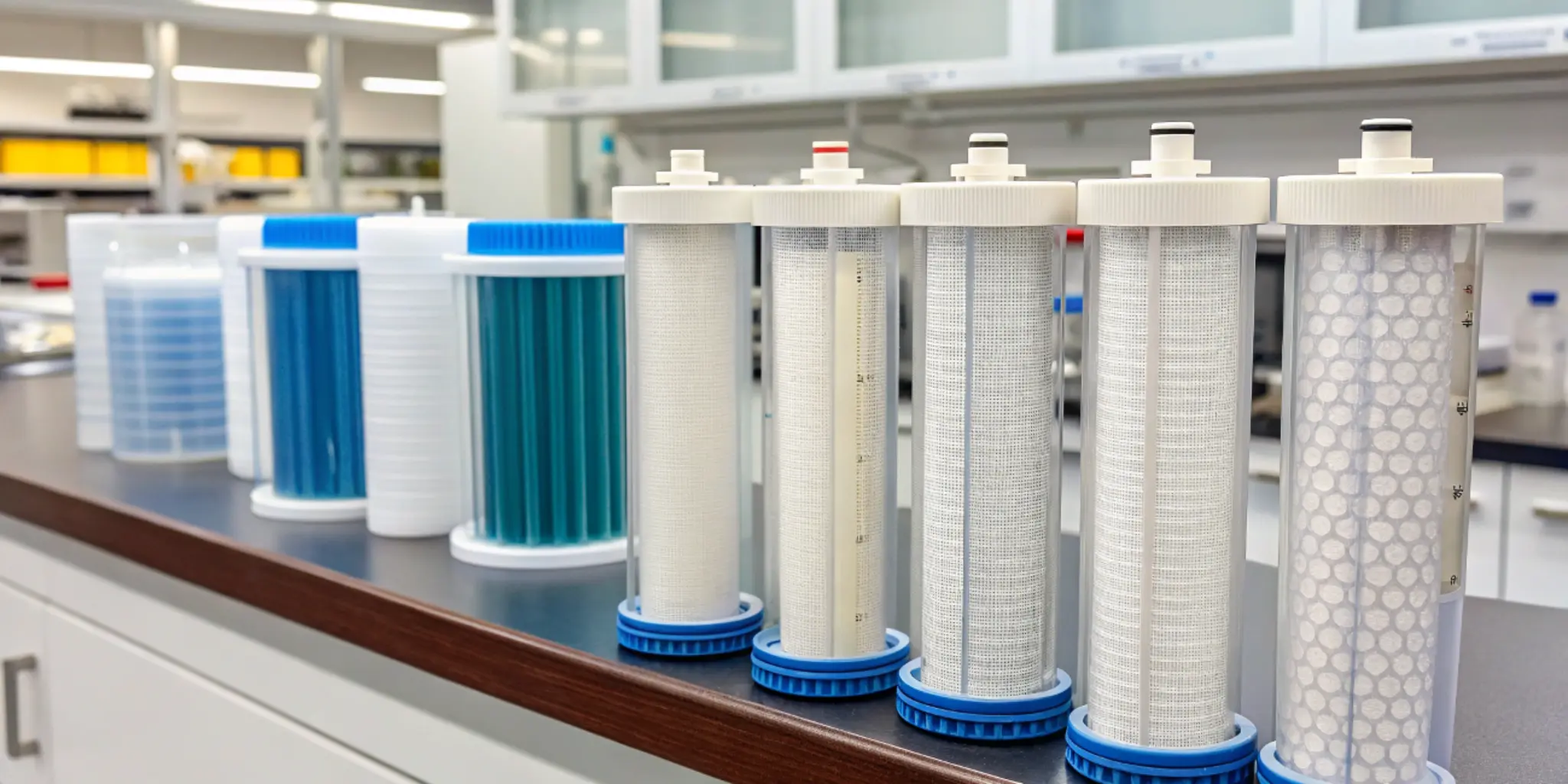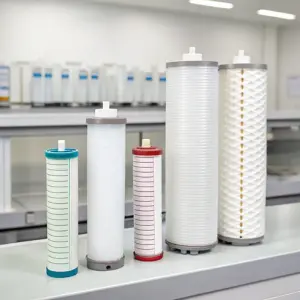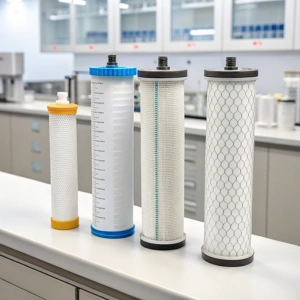Microfiltration Membrane Cartridges
Engineered for critical purity control, microfiltration membrane cartridges offer unrivaled precision in particle retention from 0.1 to 10 microns. These filters protect sensitive downstream processes in pharmaceuticals, food & beverage (F&B), electronics, and chemical production by removing bacteria, colloids, and suspended solids—while maintaining essential mineral balance.Designed for high flow, chemical resistance, and extended duty cycles, our microfiltration cartridges meet or exceed FDA, ISO 9001:2015, USP Class VI, and cGMP standards—making them ideal for sterile filtration, final polishing, and aggressive solvent separation.
What Are Microfiltration Cartridges
Microfiltration (MF) cartridges utilize size-exclusion technology, trapping particles larger than the membrane’s defined pore size. Operating at low pressure (≤30 psi), they offer energy-efficient filtration without altering fluid composition—unlike reverse osmosis.

Key Cartridge Technologies
Pleated Microfiltration Membrane Cartridge
Expanded surface area for higher dirt-holding capacity and prolonged service life.
PES Microfiltration Cartridge Filters
Hydrophilic Polyethersulfone membranes offer low protein binding—ideal for biological fluids.
PTFE Microfiltration Membrane Cartridges
Hydrophobic Polytetrafluoroethylene membranes excel in aggressive chemical and gas filtration.
Key Applications of Industrial Microfiltration Cartridges

Pharmaceutical
API sterilization, serum clarification, bacteria removal.

Food & Boverage
Clarification of juices and wines, microbial stabilization of beer and dairy.
Semiconductor & Electronics
Pretreatment in Ultrapure Water (UPW) systems.

Fine Chemicals
Purifying solvents, catalyst removal, brine processing.
Advantages of Pleated Microfiltration Membrane Cartridges
Extended Filter Lifespan: 3–5× longer than traditional depth filters due to superior surface loading.
Lower Operating Costs: Reduced change-out frequency and labor.
High Flow Rate with Low ΔP: Optimized pleat geometry ensures efficiency in high-throughput systems.
Compact Design: Fits standard housings (222, 226) without retrofitting.
PES vs. PTFE Microfiltration Membrane Cartridges
| Feature | PES Microfiltration Cartridge | PTFE Microfiltration Cartridge |
|---|---|---|
| Hydrophilicity | High (ideal for water-based fluids) | Hydrophobic (ideal for non-polar solvents) |
| Chemical Resistance | Moderate (pH 2–12) | Exceptional (pH 1–14) |
| Temperature Range | ≤ 85°C | ≤ 130°C |
| Sterilization Method | Steam, Autoclave | Dry Heat, SIP, Gamma |
| Typical Use | Biotech, F&B, lab-grade liquids | Organic solvents, air/gas sterilization |
Selecting the Right Microfiltration Filter Cartridges
Pore Size
- 0.1µm → bacteria retention
- 0.2–0.45µm → yeast/spore removal
- 1.2µm → particle clarification
Configuration
- Pleated → high viscosity, long life
- Spiral-wound → high-volume continuous flow
Material Compatibility
- PES for biocompatible and aqueous systems
- PTFE for hydrocarbons, ketones, and compressed air
Housing Interface
222/fin, 226/double O-ring, DOE—all available in multiple gasket materials.
6 Industries Transformed by Microfiltration Cartridges
Biotech: Harvesting cell cultures and protecting chromatography columns.
Wastewater: Tertiary treatment of municipal effluent and industrial discharge.
Automotive: Paint booth rinse water recovery and parts washing.
Oil & Gas: Produced water polishing and offshore water injection systems.
Textiles: Dye bath recovery, finishing chemical reuse.
HVAC: Protecting chiller loops and cooling towers from microbial growth.
Maintenance Tips for Membrane Microfiltration Cartridges
1
Backflushing: Use 0.5N NaOH or 1% citric acid to remove organic/inorganic foulants.
2
Storage: Submerge unused cartridges in 1% formaldehyde or ethanol solution if idle >48 hours.
2
3
Monitoring: Replace when ΔP >15 psi or throughput drops by 20% from baseline.
4
Integrity Testing: Bubble point or diffusion testing recommended every 30 cycles for sterile applications
4
Frequently Asked Questions
1. What is a microfiltration membrane cartridge used for?
A microfiltration membrane cartridge is used to remove particles, bacteria, and microorganisms from liquids and gases. Common applications include sterile filtration in pharmaceuticals, juice clarification in food processing, ultrapure water (UPW) production in electronics, and solvent purification in chemical manufacturing. These cartridges typically filter particles ranging from 0.1 to 10 microns.
2. What is the difference between PES and PTFE microfiltration cartridges?
• PES (Polyethersulfone) cartridges are hydrophilic, making them ideal for aqueous solutions and applications where low protein binding is critical—such as biotech, laboratory, and food-grade fluids.
• PTFE (Polytetrafluoroethylene) cartridges are hydrophobic, best for organic solvents, aggressive chemicals, and sterile venting. They offer broader chemical resistance and higher temperature tolerance (up to 130°C).
3. What pore size is best for microfiltration in water or beverage applications?
• 0.1 µm: Best for removing bacteria in sterile water systems.
• 0.2 µm: Used for bioburden control in beverage bottling and dairy processing.
• 0.45 µm: Ideal for general particle filtration and clarifying juices, wines, and oils.
4. How long do microfiltration cartridges last?
The lifespan of a microfiltration cartridge depends on the application, fluid quality, and cleaning schedule. On average:
• PES cartridges last 30–50 cycles in sterile applications.
• PTFE cartridges can exceed 100 cycles in gas or solvent filtration.
5. Are your microfiltration cartridges FDA and ISO compliant?
Yes. All our cartridges are manufactured in ISO 9001:2015-certified facilities and comply with:
• FDA 21 CFR for food contact
• USP Class VI for biological safety
• cGMP standards for pharmaceutical use
6. Can I reuse microfiltration cartridges after cleaning?
Yes—our cartridges are designed for multiple reuse cycles, especially when cleaned with validated CIP (Clean-in-Place) protocols:
• Use 0.5N NaOH or 1% citric acid for organic fouling.
• Rinse thoroughly to avoid chemical carryover.
• Run integrity tests before reusing in critical applications.
7. What’s the difference between microfiltration and ultrafiltration membranes?
• Microfiltration removes bacteria, yeast, and particulate matter (>0.1 µm).
• Ultrafiltration targets proteins, viruses, and macromolecules (<0.01 µm).
Use microfiltration for clarity and safety; ultrafiltration for molecular separation like protein purification.
8. Can microfiltration be used for compressed air or gas filtration?
Absolutely. Hydrophobic PTFE microfiltration cartridges are ideal for:
• Sterile air filtration
• Vent filters in fermenters
• Gas stream clarification
They prevent moisture intrusion and withstand dry heat sterilization, making them essential in biotech and pharma production.
9. What configurations and end caps are available for your cartridges?
We offer industry-standard configurations:
• 222 with fin or flat cap
• 226 with locking tabs
• DOE (Double Open End)
End caps are compatible with most housings and available with EPDM, silicone, Viton®, or Teflon®-encapsulated O-rings.
10. Where can I buy high-quality microfiltration membrane cartridges?
You can order directly from our website or speak to a filtration specialist for application-specific guidance. We also offer:
• Free samples
• Validation guides
• Fast global shipping
